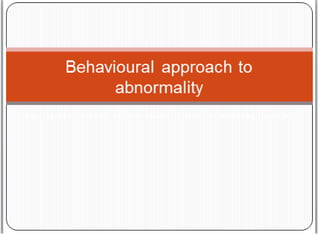Behavioural approach to abnormality
•Télécharger en tant que PPTX, PDF•
1 j'aime•2,685 vues
Signaler
Partager
Signaler
Partager

Recommandé
Recommandé
Contenu connexe
Tendances
Tendances (20)
Introduction, Aim, Objectives and Scope of Cross Cultural Psychology

Introduction, Aim, Objectives and Scope of Cross Cultural Psychology
Similaire à Behavioural approach to abnormality
Similaire à Behavioural approach to abnormality (20)
Various views on Human Learning - All 5 Theories Merged.pdf

Various views on Human Learning - All 5 Theories Merged.pdf
Classical conditioning theory and social learning theory

Classical conditioning theory and social learning theory
Week1 Learning Approach and Classical Conditioning

Week1 Learning Approach and Classical Conditioning
Behavioural approach to abnormality
- 6. Pavlov (1927) AO1 • Pavlov (1927) started from the idea that there are some things that a dog does not need to learn. • For example, dogs don’t learn to salivate whenever they see food. This reflex is ‘hard wired’ into the dog. • In behaviourism terms, it is an unconditioned response (i.e. a stimulus- response connection that required no learning). Passive learning AO2 Supporting study: Watson and Raynor (1920) “little Albert” • He thought children have fear of noises because he/her has learned it from their parents.
- 7. Operant conditioning • Learning through rewards and punishments. • Behaviour will likely to be repeated which has reinforced. • And tend to be avoided with punishment. • E.g. an individual may be rewarded for having panic attacks by receiving attention from family and friends – this would lead to the behaviour being reinforced and increasing in later life.
- 8. Skinner(1957) AO1 - Skinner (1957) demonstrated that cats could be taught voluntary responses by reward and punishment of behaviour. - Different patterns of behaviour are taught through use of different schedules of reinforcement. • Skinner's study of behavior in cats was conducted under carefully controlled laboratory conditions. AO2 • Cannot generalise it ton human species as he used animals. • Lab experiment therefore it has a low ecological validity.
- 9. Evaluation of operant conditioning • It does not take into account the role of inherited and cognitive factors in learning. • Kohler (1924) found that primates often seem to solve problems in a flash of insight rather than be trial and error learning. • We cannot generalize from studies on animals to humans as their anatomy and physiology is different from humans.
- 10. Observational/social learning theory (AO1) Social Learning is when behaviour is observed and copied. • For example girl watches mother (role model) who has OCD washing ritualistically every item in house daily. • Girl cleans own things in same way – copying mum!
- 11. Behavioural therapies AO1 • Its based on the principle of classical conditioning. • Is done by forming a hierarchy of fear, that are ranked from least fearful to most fearful. • The patient works their way up starting at the least unpleasant and practicing their relaxation technique as they go. AO2 • It is then most effective treatment. • It is a very robust therapy. • Rothbaum compared the effectiveness of a standard exposure treatment to one which used virtual reality in treating people with fear of flying.
- 13. Evaluation of behavioural approach to abnormality • The behavioural approach can provide a convincing explanation that some mental disorders are learnt e.g. someone who is on a diet. •Another problem with this approach is because it explains all behaviour as a learning process i.e. the way we are brought up and live our lives (nurture ). •It does not take into account the contribution made by genetic inheritance or chemical imbalance (nature ). •This approach does not take into account humans ability to think and influence on what happens to them.